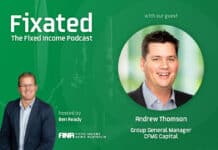
Franklin Templeton experts weigh in on Fed Chair Jerome Powell’s speech at the annual central bank symposium at Jackson Hole, USA.
In his speech, which was delivered as part of the annual central bank symposium at Jackson Hole, Federal Reserve (Fed) Chair Jerome Powell focused on the economic outlook over the relatively near term.
John Bellows, Portfolio Manager at Western Asset notes: “What implications does Chair Powell’s speech have for fixed-income markets going forward?
“First, Chair Powell seems appropriately aware of the elevated uncertainty surrounding the long-term outlook. As a consequence, he is likely on guard against the bias, well documented among economists, to over-extrapolate growth surprises today far into the future.[i] Arguably, economists should work extra hard to suppress that bias in the current environment, which is characterized by so many extraordinary circumstances, most of which are both about to end and also unlikely to be repeated. To highlight just one example: this year, consumers have weathered the storm of higher costs and lower incomes by drawing down their stock of savings. While possible this year, due to the large build-up in savings during the pandemic years, this likely will not be possible next year and certainly won’t be possible over the long run.
“Second, Chair Powell is likely aware that risk premia can be volatile, and often changes in risk premia are correlated with growth surprises. This complicates an interpretation of higher bond yields as indicative of a change in the long-run neutral rates. The past few months have been a pretty clear example of this tendency. In late March and early April many investors were concerned about regional bank stress, and the heightened recession risks that accompanied it. In that environment, bond yields declined along with the prices of risk assets. As growth proved resilient through the summer, however, investors became more optimistic, which corresponded with both higher bond yields and higher prices for risk assets. It’s not at all clear how much this had to do with estimates of long-run economic potential.
Also read: Are US Treasuries a Bargain?
“Third, Chair Powell is undoubtedly aware that expectations for long-term interest rates may depend on the near-term success of the Fed’s policies. The Fed’s eventual success in bringing down inflation may influence longer-term bond yields along two dimensions. The inflation expectations, and inflation risk premium, embedded in long-term bond yields will decline straightforwardly. Perhaps more consequentially, further declines in the inflation rate will eventually allow the Fed to return real interest rates to more normal levels. New York Fed President John Williams recently suggested that process could begin as early as next year, conditional on inflation moving back toward the Fed target. As that process gets underway, market participants will likely reduce their expectations for long-term real rates as well. But inflation needs to continue declining first. Hence Chair Powell’s focus, appropriately, on the near term, and his apparent reluctance to get drawn into a discussion of the long term.
“In our view, all of these points suggest there may be considerable value in the bond market at current yields. The extraordinary nature of the post-pandemic environment cautions against over-extrapolating resilient growth too far into the future. Further, this year bonds have been negatively correlated with risk assets. Negative correlations are useful in constructing diversified portfolios, and can be particularly useful during periods of optimism and highly valued risk assets.
“Finally, long-term interest rates are currently elevated both relative to recent history as well as relative to most estimates of normal. This is particularly true for long-term real rates, which have borne the brunt of the most recent repricing. Further declines in inflation in the near term—which remains Chair Powell’s focus, as evident in his speech today—will likely correspond with a decline in those long-term rates.”
Jack McIntyre at Brandywine Global adds: “It was a balanced but not trend-changing speech, even if the Fed kept the ‘Mission Accomplished’ banner in the closet. It leaves the Fed with needed optionality, to either tighten more or keep rates on hold. There was a hawkish tone, emphasizing that the Fed’s job is not complete and making it clear that 2% is the inflation objective.
“However, the speech did end on a more constructive note, highlighting that the policies to date are having an impact on the economy via the labor market where “extreme tightness” is dissipating. Now, the markets can get back to focusing on the economic data, which will be much more important on giving direction to the financial markets than Fed policy. The Fed is okay with the recent wobbliness in the equity market as it will tighten financial conditions more than another rate hike. We are not making changes to our fixed income portfolios based on this speech.”
Stephen Dover, Chief Market Strategist at the Franklin Templeton Institute also notes: “In this year’s much-anticipated speech at the Fed’s annual central bankers’ gathering in Jackson Hole, Chairman Jerome Powell appears to have employed Greenspan’s speechwriter. Powell said a lot about the economy and inflation, but he obscured a great deal about future Fed policy. Yet beneath the (intended?) fog of his remarks was a worrisome message for devotees of soft-landing scenarios. Fasten seatbelts—the arriving passengers won’t enjoy a view of the majestic Tetons and should brace for a bumpy landing.
“The initial market response has been minimal. Equity and bond prices bounced around immediately after the speech but diverged somewhat by the close as stocks finished higher while bond yields rose.
“We’re not sure that’s right and here’s why:
- First and foremost, interest-rate cuts are not coming soon and will only occur once US unemployment rises above 4%. That could be well into 2024.
- Second, the US economy must now slow, which puts at risk the expected sharp recovery of corporate profits currently expected by the consensus of Wall Street analysts for 2024.
- Third, the Treasury yield curve will likely remain inverted and could invert further. That’s because the Fed must be willing to risk recession in an effort to restore price stability, which is likely to occur. It rarely pays to “fight the Fed,” and an inverted yield curve is the logical way to express that view.
- Finally, if the Fed is wrong in the sense that inflation can fall without the need for “slack” in the economy, then it has embarked on a policy error. If so, reversing course later means undoing today’s tightening much faster and more aggressively than would otherwise be the case. Ultimately, investors may be surprised by how rapidly the Fed might eventually be forced to unwind its tightening stance.”
[i] “Learning about the long run,” L. Farmer, E. Nakamura and J. Steinsson, UC Berkeley, Feb 2023. https://eml.berkeley.edu/~jsteinsson/papers/learning.pdf






























